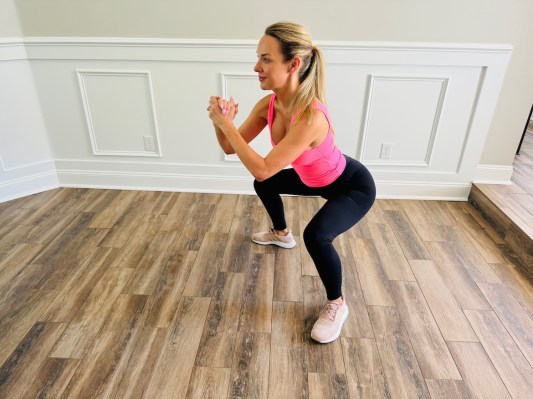We promise you’ll love them.
If you’re unable to do lunges due to an injury, have trouble balancing, or you simply don’t like them (no judgment!), there are plenty of alternative exercises that can be just as effective.
“Forward lunges are a favorite for their effectiveness in targeting the quads and engaging the glutes. However, they’re not without drawbacks,” says Joey Thurman, CPT, certified personal trainer, author, and founder of Fun Fitness Bros. “Some individuals experience knee pain, dislike the exercise, or struggle with maintaining proper form, which can diminish the effectiveness and increase the risk of injury.”
We talked to fitness experts who shared their favorite lunge alternatives to strengthen and tone your legs.
Benefits of lunges
In addition to cardio exercise, it’s important to incorporate strength exercises, like the lunge, into your routine at least twice a week. Lunges are a favorite exercise of trainers for several reasons.
1. They strengthen your lower body
This one move works your hip, knee, and ankle muscles. Specifically, the lunge strengthens your gluteus maximus, hamstrings, quads, and calves.
Improved strength in your legs makes everyday activities, such as taking the stairs, walking, or bending down, that much easier. It also translates into sports activities, like improved running speed, according to the National Strength and Conditioning Association (NSCA).
2. They build core strength
The lunge strengthens more than your legs. Because you are in a staggered-stance position with the lunge, your core muscles kick in to help stabilize you to prevent you from losing your balance. A strong core has many benefits, including helping to prevent back pain and improving posture.
3. They improve balance
The staggered-stance position of the lunge challenges your body to work all those muscles that help you stay balanced, like your core muscles. This is especially important as you get older to help prevent falls.
Drawbacks of lunges
For some people, lunges may not be the best exercise—or the exercise should be modified. Let’s look at some of the cons of lunges.
1. They only work your body in one direction
“Lunges can be a great exercise choice, but one major drawback is that you are only moving in the sagittal plane—or only moving forward or backward,” says Grayson Wickham, DPT, CSCS, physical therapist, certified strength and conditioning specialist, and founder of Movement Vault. “Most people are already performing plenty of movements going straight forward—think: walking, running, etc.—and don’t perform enough side-to-side and rotational movements.”
This can lead to mobility and stability issues in your rotator muscles and the muscles that are located on the side of your hips, Wickham explains. These muscles include your gluteus medius and small hip internal and external rotator muscles.
“Having poor mobility and stability in these muscles can cause compensations in your knee, which can eventually lead to knee joint wear and tear, and eventually knee pain and injury,” he says.
2. They require flexibility
“Lunges can also be challenging if you have tight hip flexors or poor mobility in your big toe,” Wickham says. “When you have tight muscles in these areas, it can lead to knee or big toe pain.”
If you find you can’t do the lunge with proper form or you have knee pain while doing it, try doing hip flexor stretches to improve your flexibility.
If you’ve had a toe injury and have a reduced range of motion, you may need to avoid the lunge altogether to avoid injuring your knee.
3. They require balance
“Lunges also require more balance and stability, as your feet are not side by side and are one in front of the other, which provides a narrow base of support,” Wickham says.
If you feel like you can’t safely do a lunge, you should ensure you have a stable surface to hold on to, or don’t exercise until your balance improves. Exercises to strengthen your core can also help.
4. They can cause knee pain
If you aren’t doing the exercise with proper form, lunges can cause knee pain and injuries. If it is a form error, like having your feet too close together and not stepping out far enough, then switching up your form can help.
If you have injuries or lack of mobility that are preventing you from doing the lunge correctly, you should make modifications or do other strengthening exercises.
“Lunges can be a great exercise choice, but one major drawback is that you are only moving in the sagittal plane—or only moving forward or backward.” —Grayson Wickham, DPT, CSCS
Best lunge alternatives
“For those seeking alternatives to forward lunges, focusing on exercises that promote knee flexion can be beneficial,” Thurman says.
Here are five lunge alternatives to add to your exercise routine.
1. Squat
“Performing a standard squat is a good lunge alternative because both of your feet are on the ground side by side, which is a good alternative if you have tight hip flexors or a tight big toe joint,” Wickham says. It also strengthens your glutes, hamstrings, and quads—similar to the lunge.
- Stand with your feet shoulder-width apart, shoulders back, your toes slightly turned out, and your hands clasped in front of your chest.
- Bend your knees as you push your hips back and shift your weight onto your heels as you squat down.
- Keep your chest up and your core tight.
- Squat down until your knees are parallel to the ground—or stop before that if you have pain or can’t maintain proper form.
- Squeeze your glutes and push through your heels to straighten your legs and return to a standing position.
- Perform 1 to 3 sets of 12 to 15 reps.
2. Cossack squat
“Performing Cossack squats are a good alternative because they emphasize movement in a frontal plane of motion—aka side to side—as well as stretch out your inner thigh adductor muscles,” Wickham says.
- Stand with your feet wider than shoulder-width apart with your toes pointed slightly out and your hands clasped in front of your chest.
- Shift your weight to your right side, bending your right knee as you squat down on that side.
- Your left leg will stay straight, as you point your left toes straight up with your left heel on the ground.
- Keep your torso straight up. Squat down as far as you can comfortably go.
- Push back up with your right leg to the starting position.
- Repeat on the other side.
- Perform 1 to 2 sets of 5 to 10 reps on each side.
3. Single-leg split squat
“Single-leg split squats are a good alternative if you have tight big-toe joints that lead to foot pain while performing lunges,” Wickham says.
This exercise, which is also called a Bulgarian split squat, also works your core and balance, similar to the lunge. Start out with just your body weight, and then progress to holding weights.
- Stand a few feet in front of a bench, box or chair, facing away from it. The bench, box, or chair should be at knee-level and about 2 feet behind you.
- Reach your right foot back and place the top of your foot flat on the surface. Your right foot should be far enough in front that when you bend your knee, your knee doesn’t come over your toes. You may need to hop that foot forward until it’s far enough in front.
- Lean your torso forward slightly and bend your front knee to sink your hips toward the floor as low as you can comfortably go.
- Your front-leg shin should be vertical or close to it, while your back knee should point down toward the floor. If either leg is out of place, move your front foot forward or backward until you’ve found the ideal positioning.
- Push through the middle of your front foot to return to standing.
- Repeat.
- Perform 1 to 2 sets of 10 to 12 reps on each leg.
4. Step-up
“Steps-ups on a box are a good alternative, as these work similar muscles, but demand less mobility and balance,” Wickham says.
- Stand in front of a bench or step with your arms down by your sides. The taller the step, the more demand on your muscles.
- Step up with your right foot, pushing up until your right leg is straight. Try to keep your left foot elevated and off the step.
- Pause at the top, then slowly lower yourself down.
- Perform 1 to 3 sets of 12 to 15 reps on each side.
5. Reverse lunge
“For your lunge lovers who want to keep them in their arsenal, try incorporating reverse lunges,” Thurman says. “This lunge variation tends to involve more glute activation, poses a lower risk of injury, and generally feels smoother for most people [compared to forward lunges].”
As a bonus, reverse lunges put less stress on your knee joint compared to forward lunges, according to a small 2021 study in Physical Therapy in Sport.
- Start by standing with your feet hip-width apart and your hands on your hips.
- Step back with your right foot, landing on the ball of your foot.
- Bend your right knee in a lunge position, lowering yourself down until both knees are at a 90-degree angle (or as low as you can comfortably go).
- Keep your trunk upright and your hips facing forward.
- Push off with your right foot to step your right leg back to the starting position.
- Perform 1 to 3 sets of 12 to 15 reps on each leg.
Safety tips
“If you have pain while performing lunges, first try to decrease the distance that you’re stepping while performing your lunge, Wickham says. “If you still have pain while performing lunges, right after the exercise, or within 24 hours afterward, you should choose a different leg exercise instead of lunges.”
If you’ve had a recent injury or have another medical condition, talk to your doctor before starting an exercise program. If you have balance issues, make sure you have a stable surface to hold on to and someone assisting you.
FAQ
1. What machine is a good substitute for lunges?
“I’m not a big fan of machines for the most part as they limit your degree of freedom when performing a movement—and they decrease the demand of the stabilizing muscles needed,” Wickham says. “In most cases, you just need to improve your joint mobility and stability in order to perform exercises with free weights.”
In the case that you would like to use a machine, though, leg presses or hack squats can be a good substitute, Wickham says.
Thurman agrees that machine leg presses, as well as leg extensions, are a good substitute.
“Options like machine leg extensions isolate the quads without the complexity of lunges,” Thurman says.
2. How do you do lunges if you have bad knees?
“Performing lunges with less distance between your front and back foot will decrease the difficulty and balance demands,” Wickham says.
Keep the range of motion in your pain-free range.
“You can also make them easier by performing them in a limited range of motion, such as only allowing your knee to descend part of the way versus your knee moving all the way down to the ground,” he says.
You can also perform a bodyweight lunge while holding on to something for support such as a wall, chair, or box, Wickham says.
In addition to reverse lunges, Thurman says walking lunges are another option.
“This variation promotes forward movement, distributing weight more evenly and potentially mitigating the knee and form issues associated with stationary forward lunges,” he says.
3. How can I work my legs without lunges?
In addition to the exercises above, activities like walking, running, and cycling will all strengthen your leg muscles. You can run steps and incorporate hills to further strengthen your legs.
Jumping rope and box jumps will strengthen your legs and give you an additional cardio boost as well. Workouts such as Pilates and yoga will strengthen your legs, work your core, and improve your overall flexibility.
Recommended Story For You :

The alpine secret for healthy weight loss

The Most Potent Fast-Acting Formula For Incinerating Stubborn Fat

Real Cortexi Users Real Life‑Changing Results

This Cold Drink Might Trigger Your Prostate

Red Boost is a powerful new formula for boosting male sexual health.

Everything you eat or drink eventually reaches your liver for processing.

Brand New Probiotics Specially Designed For The Health Of Your Teeth And Gums

Empowering You to Take Control of Your Blood Sugar Health!

Scientists Finally Discover the Root Cause of Belly Fat and Unexplained Weight Gain






